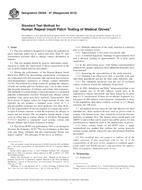Potřebujeme váš souhlas k využití jednotlivých dat, aby se vám mimo jiné mohly ukazovat informace týkající se vašich zájmů. Souhlas udělíte kliknutím na tlačítko „OK“.
ASTM D6355-07(2012)
Standard Test Method for Human Repeat Insult Patch Testing of Medical Gloves
Automaticky přeložený název:
Standardní zkušební metoda pro Human Repeat Insult Patch Testování Rukavice lékařské
NORMA vydána dne 1.12.2012
Informace o normě:
Označení normy: ASTM D6355-07(2012)
Poznámka: NEPLATNÁ
Datum vydání normy: 1.12.2012
Kód zboží: NS-34805
Počet stran: 7
Přibližná hmotnost: 21 g (0.05 liber)
Země: Americká technická norma
Kategorie: Technické normy ASTM
Kategorie - podobné normy:
Anotace textu normy ASTM D6355-07(2012) :
Keywords:
ACD, allergic contact dermatitis, allergy, dermatitis, Draize, glove, latex, natural rubber latex, repeat insult patch test, RIPT, rubber, sensitization, synthetic rubber, ICS Number Code 11.140 (Hospital equipment)
Doplňující informace
| Significance and Use |
|
4.1 This RIPT method assesses the potential of skin sensitization with a particular medical product by repeated topical applications to the skin of selected subjects. This is a procedure that has the potential to detect many, but not all, sensitzers. This requires multiple applications to induce a cell-mediated Type IV immune response sufficient to cause an allergic reaction. 4.2 In general, the sensitization procedure requires 10 multiple 48-h (72-h on weekends) applications of patches containing the study material over a three-week induction phase. Induction is followed by approximately a 21 day rest phase to allow the development of any latent sensitization. Study subjects are then challenged by the application of two consecutive 48-h patches of the study material to naive sites. Responses are evaluated and graded after the removal of each consecutive 48-h patch application. 4.3 Although this test method is a clinical method, it may be used as part of a risk analysis to determine the potential for Type IV allergic contact dermatitis. 4.4 This test method assumes that good clinical practices will be utilized, including adequate training of practitioners. |
| 1. Scope |
|
1.1 This test method is designed to evaluate the potential of glove materials under test to induce and elicit Type IV skin sensitization reactions (that is, allergic contact dermatitis) in humans. 1.2 This test method should be used by individuals experienced in or under the supervision of those experienced in the use of good clinical practice procedures. 1.3 During the performance of the Human Repeat Insult Patch Test (RIPT) for determining sensitization, investigators are confronted with skin responses that represent skin irritation (non-immunologic responses) or allergic contact dermatitis (ACD). The numerical scoring system for grading the intensity of both are similar and test facilities may vary in their scores that describe intensities of allergic and irritant skin responses. The hallmark of a mild allergic contact dermatitis is a sustained palpable erythematous reaction. Delayed-type allergic contact reactions from patch tests have intensity characteristics that favor scores of higher values for longer periods of time and typically do not produce a minimal score (score of 1, a just-perceptible erythema) for short durations (less than 48 h). It is the responsibility of the investigator to evaluate the scores in light of irritant reactions so that the responses are allergic in nature and not irritant. The investigator should denote a final score as either due to contact allergy or irritation. Paragraphs 9.5-9.5.5 describe a commonly used scoring system and discuss allergic and irritant responses in detail. 1.4 The Draize RIPT was published in 1944 as an attempt to decrease the frequency ACD.2 The test techniques at that time were just being validated and this experimental design was largely empiric.3 The principle of the test is as follows: 1.4.1 Multiple inductions of the study material at relatively non or low irritancy levels, 1.4.2 Approximately a two-week rest period, and 1.4.3 A standard diagnostic challenge of approximately 48 h and a delayed reading at approximately 96 h after patch application. 1.5 In the intervening years, with further experimentation added to this empiric approach, three additional principles have been learned: 1.5.1 Increasing the concentration of the study material, 1.5.2 Defining a no effect level (this is possible with only individual ingredients and not the final study material), and 1.5.3 The enhanced sensitivity and the use of occlusion (where occlusion would not ordinarily be present). 1.6 In 1945, Henderson and Riley1.7 All medical devices must be safe and effective for their intended use. Since medical devices such as gloves come in contact with human tissue, they should be tested for biocompatibility in animals first. The human repeat insult patch test (RIPT) is one test that can be used to test rubber gloves for skin sensitization to chemicals used in the manufacture of gloves. 1.7.1 Since various forms of the RIPT exist, a single standardized test method that outlines the testing protocol, scoring system, and the criteria for skin sensitization should be developed. 1.8 This standard does not purport to address all of the safety concerns, if any, associated with its use. It is the responsibility of the user of this standard to establish appropriate safety and health practices and determine the applicability of regulatory limitations prior to use. |




 Cookies
Cookies
